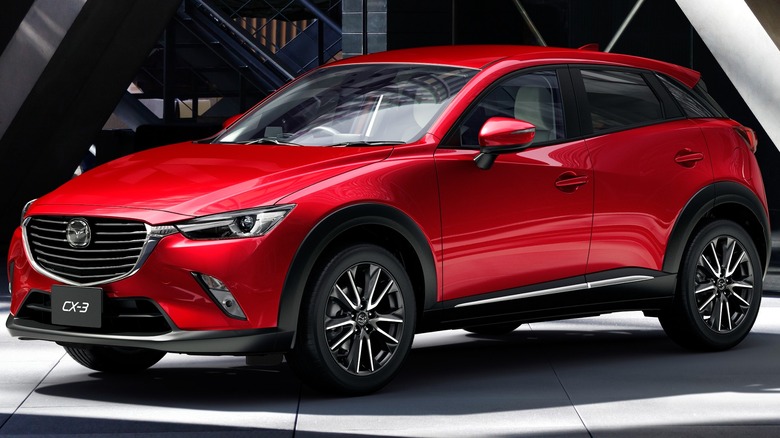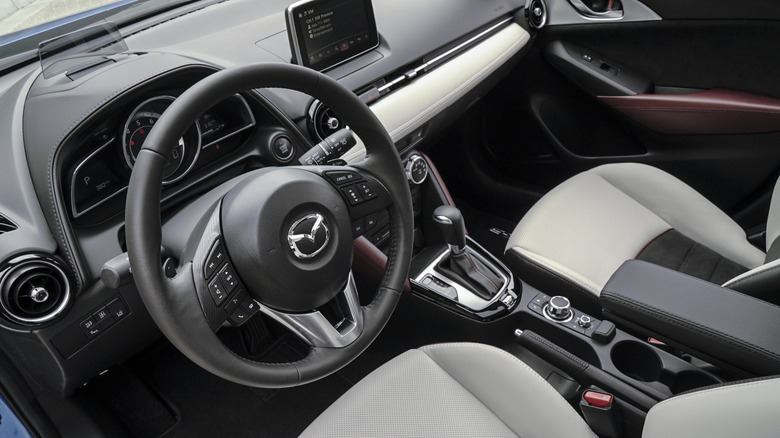Are There Any Mazda CX-3 Years You Should Avoid? Here's What You Need To Know
The Mazda CX-3 launched in 2016 as a subcompact-crossover that features refined looks, a premium interior, and responsive handling. In fact, during our 2016 Mazda CX-3 First Drive, we noted that while this crossover may look nothing like a sporty Miata, deep down, the CX-3 embodies its spirit. This Mazda offers the automaker's Skyactiv technology, which attempts to balance performance and efficiency across several areas of the vehicle, helping to save money at the pump, while still remaining an engaging experience behind the wheel. The CX-3's elegant exterior is a result of their KODO: Soul of Motion design approach, which creator Ikuo Maeda explains, "What sets Mazda Design apart from other brands is an obsession with ultimate form of beauty."
Despite the praise, the CX-3 was never able to exceed its inaugural sales figures of 18,557 units, with 2020 showing nearly half of the previous year's totals, according to GoodCarBadCar.net. In 2021, Mazda discontinued the CX-3 for a few reasons, including its sluggish sales numbers. Fortunately, for those in the market for a used crossover, the CX-3 may be just the right fit. However, not all the CX-3 iterations from Mazda are remembered for positive reasons, and there are certainly a few years you'll want to skip. Most notably, the crossover's first year in 2016 and its subsequent follow up in 2017.
The 2016 Mazda CX-3: Engine woes and technical service bulletins
Many vehicles have a challenging first-production year, and that's the reason why you should never buy the first model year of a new car. One of the problems with the first CX-3 had to do with its engine, which reportedly suffered trouble starting and could suddenly lose power during operation. When navigating today's congested motorways, a sudden drop in engine power can put the driver in a dangerous situation, unable to react to the vehicles around them. Consumer Reports rated the 2016 Mazda CX-3 only a 47 out of 100 in terms of reliability. Also concerning, this particular model year is considered an elevated risk for major repair by Kelly Blue Book.
Another major red flag for the 2016 CX-3 is that it's weighed down by 791 technical service bulletins (TSB), far outpacing any other year of its production run. A TSB documents minor malfunctions that shouldn't interrupt operation, and these briefs originate from the automaker. While no vehicle is perfect, it might give you pause knowing there are so many issues with this model year.
The 2017 Mazda CX-3: Better, but the automaker was still rooting out problems
Fortunately, some of the previous year's issues were mostly resolved, with driver reports on CarComplaints.com dropping to less than half of what they were in 2016. However, the 2017 CX-3 failed to make J.D. Power's top eight best small SUVs for that year, with its score of 74 out of 100 in the areas of quality and reliability.
Although complaints were fewer in number, there were still some issues that carried over from 2016. One of these problems was corrosion building up on the A/C condenser resulting in leaks and a lack of cold air. Fortunately, Mazda initiated a warranty extension to help cover this issue specifically for the 2016 and 2017 CX-3 models.
The CX-3 continued to get better with each iteration, especially after 2017, and still ended up making our list of the most reliable Mazda models ever made. You can find many 2018 and 2019 CX-3s for under $20,000 with less than 50,000 miles, making this Mazda an affordable option for those interested in a used crossover.


